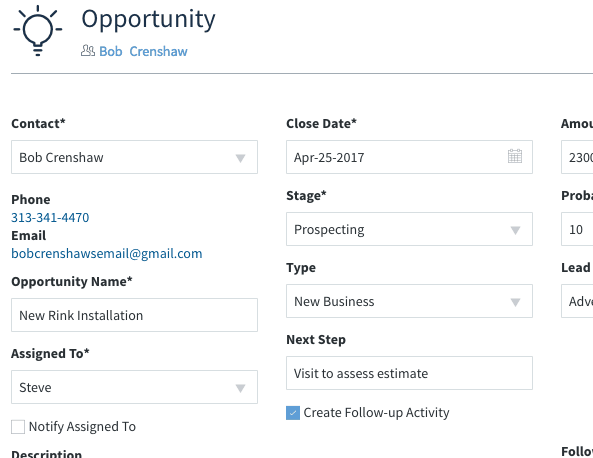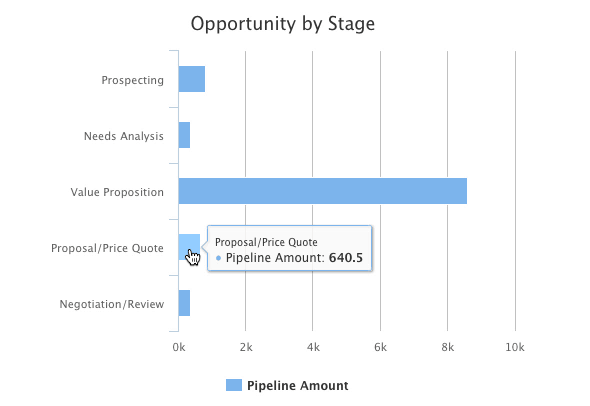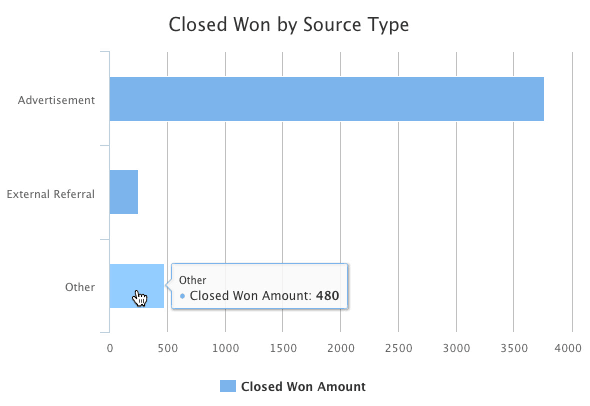As a small business owner, do you ever feel like you’re drowning in a sea of business buzzwords? Well, you’re not alone. We’re here to answer the common question, “What is lead and opportunity in CRM?” and help you understand the process from end to end.
Lead management and opportunity management are often used interchangeably, but they’re not the same thing. These are both critical functions for every small business, so it’s important to make a distinction between them.
Not sure what the difference is? Keep reading to find out.
What is lead and opportunity in CRM
To start, let’s note that there are different schools of thought when answering, “What is lead and opportunity in CRM?”
Some describe a lead as a contact you don’t know much about. To these individuals, leads only turn into sales opportunities when they express interest in buying from you. However, this mindset gets confusing.
For the sake of clarity, we view a lead as a potential customer whose contact information you’ve acquired. Note that a lead may refer to an individual or a company, depending on your sales process and business.
When it comes to sales opportunities, you can think of an opportunity as a source of potential revenue for your business. In other words, it’s any chance you see to sell your product or service to someone.
Since sales opportunities aren’t the same as sales transactions, opportunities exist solely in your CRM or sales tracking system and do not affect your finances.
Not surprisingly, leads and opportunities are closely related. For example, say a marketing consultant is approached by a retail store that needs help with its social media strategy.
The consultant now has a new lead (the store) and a new opportunity (to consult on social media strategy).
Method:CRM users: Stay organized while speaking to multiple people at the same company by adding new contacts to an existing lead.
Leads vs. opportunities: A closer look at the differences
As explained above, a lead can be a company, an individual, or an individual within a company that your sales team has identified as a potential customer.
You may or may not have had any direct contact with a potential lead, but they have agreed to share their contact information with you.
It’s important to note that not all your leads are equal. Below are the seven major ways to categorize your leads.
What are the different types of leads in sales?
- Cold leads — These are leads that have had minimal nurture and little-to-no contact with your business.
- Warm leads — These are people who are familiar with your company and what you do. You or your team may have already had contact with them in the past.
- Hot leads — A hot lead is a contact with a good chance of purchasing from you. They may have reached out for more information on your products or expressed interest in buying from you.
- Information qualified leads (IQLs) — These are leads that have come to you through gated content like an ebook or report. You have their contact information, but these leads may have not shown specific interest in purchasing from you.
- Marketing qualified leads (MQLs) — MQLs are considered to be further down the sales funnel than IQLs. MQLs are similar to IQLs in the sense that they come from your marketing efforts, but are usually more familiar with your business and products.
- Sales-ready lead — A sales-ready lead is one where a potential customer requests to speak with a salesperson. They may still be on the fence, but are interested enough to discuss the possibility of purchasing from you.
- Sales qualified leads (SQLs) — Once a member of your sales team has qualified a lead or opportunity, they are now an SQL.
How to decipher lead quality
Some leads are ready to buy the product or service you offer, while others have just recently heard about your business. This is where lead qualification and prioritization come in.
When evaluating lead quality and the likelihood of a purchase, the BANT framework is helpful.
The BANT method uses the following criteria to evaluate leads:
- Budget: Does this lead have enough of a budget to buy my goods or services?
- Authority: Does this lead have the decision making power needed to buy from me?
- Need: Does this lead need my products or services?
- Timing: When is this lead looking to purchase?
By asking yourself these questions, lead prioritization becomes a lot easier. And better yet, using BANT might even increase your win rate and sales!
What should I look for in my leads?
When making the distinction between what is lead and opportunity in CRM, your lead is ideally the person with purchase authority or is someone who can influence the decision maker. It’s even better if your lead is currently in the market for the product or service you sell.
You’ll also want to do your best to find leads that align with your target industries and buyer personas.
For example, imagine that you sell the forklifts that warehouses use for order picking.
The type of leads you want are companies that have warehouse operations. As a result, you should seek out and prioritize the Procurement Leads and Warehouse Managers at these companies, as you can assume they’ll check at least half of the BANT requirements.
Not to mention, they’ll know the difference between forklift models and understand the benefits of your forklifts over those of your competitors.
When it comes to sourcing leads, a targeted approach as mentioned above results in more sales opportunities and closed deals.
Now that you’ve learned some lead generation best practices, let’s move on to when your leads become opportunities.
When does a lead become an opportunity?
When it comes to answering, “What is lead and opportunity in CRM?” opportunities are associated with leads that have a high chance of converting into a sale. The transition from a lead to a sales opportunity often results in some qualification by your sales team to ensure only legitimate opportunities go into your sales pipeline.
How do I convert leads into sales opportunities?
Your business probably has specific steps that your sales and marketing teams follow to get a lead through your sales funnel, some of which we’ve covered already.
On a high level, lead and opportunity management help you convert leads into opportunities by trying to accomplish the following:
- Seeking out the right leads and contacts. These are the people who need your products and services, can afford them, and have the authority to make or influence the purchase decision.
- Having effective communications with a lead or contact. This means establishing touchpoints for engagement with potential customers (ie., a mobile app or web form), showing the value that your service or product provides in addressing their needs, and developing a rapport with them. You can achieve this through the content on your website, social media engagement, and email nurture campaigns.
- Following up with leads to qualify them as opportunities. Usually for a lead to become a sales opportunity, there will have to have been some direct communication between the potential client and someone on your sales team or in your organization who recognizes that there is a high possibility of a sale.
Of course, these are just the basic ways of converting a lead into a sale. But, usually, all three happen when leads become sales opportunities.
Where do leads and opportunities come from?
Since we’re all on the same page regarding what is lead and opportunity in CRM, let’s look at how to get more of them.
Thankfully, there are countless ways to acquire new leads and unlock sales opportunities. A few examples are:
- Networking at events.
- Online lead gen forms.
- Getting referrals from existing customers.
Depending on how you generate leads, you may acquire sales opportunities simultaneously, or the opportunities may arise later.
Regardless, your best shot at turning these leads into customers is to get their contact information into your CRM so you can follow up with them.Method:CRM users: Click “Setup” on your Web to Lead app to change the Method user that new web leads are assigned to by default.

What is lead and opportunity in CRM?
Before getting into what is lead and opportunity in CRM, let’s take a quick refresher on CRM.
CRM stands for customer relationship management. It’s a system or process your company has for handling all the interactions you have with your current, former, and potential customers.
Using a CRM to manage your leads and opportunities is helpful because it:
- Simplifies your lead qualification and nurture process.
- Automates time-consuming and manual sales workflows.
- Tracks your sales opportunities and leads’ progression.
- Is categorized for better organization so each lead is targeted with specific marketing campaigns.
Every lead is managed within the CRM system and is updated with new interactions or data, which helps you:
- Speed up your sales process.
- Better connect with leads.
- Become a top sales performer.
What’s the difference between lead, opportunity, and contact management in your CRM?
Next, let’s look the difference between contacts and what is lead and opportunity in CRM.
To start, lead management is the process of qualifying, tracking, and engaging with your potential customers.
Using a consistent qualification methodology (such as BANT) helps you identify which leads are most likely to buy. As you generate leads, you can identify each one that requires follow-up to move forward and reduce the length of your sales cycle.
Method CRM lets you rate leads as hot, warm, or cold, making it easy to filter for the most promising prospects.
The rationale for opportunity management in a CRM is similar. Ideally, you want to focus your energy on the highest-value deals that are most likely to go through. You accomplish this by assigning opportunity stages in Method CRM.
Each stage, from prospecting to negotiation, has an assigned probability percentage that indicates how close you are to closing the deal and shows you the potential revenue in your pipeline.
Now onto contact management. Contact management is the storing, organizing, and tracking of your:
- Leads.
- Customers.
- Vendors.
Using a CRM is particularly valuable for contact management as it acts as a hub for all the information you have on these business relationships.
When it comes to contact management, your CRM is a central record of your contacts’:
- Phone numbers.
- Addresses.
- Transaction history — and more!
By housing all this data in one system, you ensure the information you need is easy to find and share with your whole team.
With plenty of moving parts associated with lead, opportunity, and contact management, understanding what is lead and opportunity in CRM is a great way to keep track of all this information.
How do I create a customer relationship management system for my business?
There is not one specific answer to this question, as each business implements a CRM process that is customized to meet its needs.
Having said that, there are a few things that a CRM system tries to accomplish regardless of what business you’re in. Here are the key purposes of a CRM solution like Method:
- Act as a contact goldmine — Your CRM holds all the information about customers, leads, and vendors, including all previous communication and interactions your business has had with them.
- Instant access to up-to-date information — A CRM keeps everyone connected and empowers your team to make decisions with data that are accurate and updated in real time.
- Provide a 360-degree customer view — A CRM gives you insights into the behavior of your leads and customers that you can use to improve your marketing and sales strategies.
- Streamline your sales and customer service — The online portals many CRMs offer take work off your team’s plate by enabling immediate self-service for your customers.
How CRM helps in lead management
CRM solutions play an important role in helping you capture leads. With a CRM, each lead is captured from various sources and is identified at the initial stage before it is tracked through the sales funnel — with little to no work from you needed.
A CRM tool makes sure every lead:
- Is prioritized based on potential value.
- Is segmented based on demographics or behavior.
- Is scored based on likelihood to convert.
- Is monitored for activity and engagement.
- Is analyzed for sales forecasting.
Using these CRM metrics offers insights into customer behavior and preferences that is measured against sales goals. They also help you:
- Organize lead information.
- Monitor communication.
- Ensure a timely follow-up.
Knowing all the details is the only way to tell the difference between what is lead and opportunity in CRM.
Stages of a sales opportunity
A sales opportunity goes through several stages in the CRM process that contribute to the success of the conversion. These stages are:
Discovery
The discovery stage is the first point of contact with a potential lead. At this stage, you use CRM tools to gather as much information as possible about the lead. These details are crucial for understanding the lead’s needs and how your product or service can meet them.
Proposal made
Once you identify what is lead and opportunity in CRM and how your products or services might be a good fit, you’re ready to make your tailored proposal.
Your CRM system will make sure the lead is documented with all relevant details and ensure this information is communicated to the sales team. Each lead is assigned to a specific sales rep depending on how that lead is qualified based on set criteria.
You can assign a qualification process to your sales reps to problem-solve how a lead progresses through different stages.
Closing
The closing stage is the final step, where your lead is closed either as won or lost. Your salespeople can use the analytics support provided by CRM software so that each lead is engaged through personalized interactions.
CRM systems aid in the closing process by letting you manage prospect conversion and ensure every lead is nurtured with relevant content for a simplified transition to closing.
Who should care about lead management and opportunity management?
Lead management is of great interest to marketing and sales teams. Helping your teams identify what is lead and opportunity in CRM is important to your revenue generation. Here’s why.
Your marketing team wants to know who your leads are and where they came from, so they can design effective email campaigns and invest in marketing efforts with high ROI.
Meanwhile, your sales team needs to link those leads to opportunity management so they can:
- Identify potential sales.
- Build relationships.
- Generate revenue.
The prospect of revenue also makes opportunities in the pipeline very important to sales managers, as they use pipeline management data to forecast future performance.
Of course, some small business owners wear all of these hats. In this case, all of the above is relevant to knowing what is lead and opportunity in CRM.
Method CRM users: Check out the “Opportunity by Stage by Close Date” chart for a visual overview of how opportunities are distributed across different stages in your pipeline.

What is the difference between lead management and opportunity management?
The main difference between lead management and opportunity management is that lead management focuses on identifying and nurturing potential customers. On the other hand, opportunity management deals with a qualified lead that is converted into a potential sale. Opportunities are further down the sales pipeline and are actively considering a purchase.
Your goal is to convert a lead into an opportunity as it represents potential revenue for the company. Both roles are critical to what is lead and opportunity in CRM.
What happens to leads and opportunities after you close the sale?
Every lead starts as a potential customer, but what do you do when they become a full-fledged paying customer?
When you close a deal, the best practice is to update the stage of the opportunity to “Closed Won.” Next, you’ll have to convert the lead into a customer.
Luckily, doing this in Method CRM is as easy as unchecking a box. Your newly converted customer will automatically sync over to your QuickBooks file, along with their contact and billing information.
In Method CRM, closed won sales opportunities will remain in the CRM and will not sync to your QuickBooks account. They will no longer appear in your sales pipeline, but they will appear in the won charts section of your Opportunities app, and you can refer back to them anytime.Method CRM users: If you created an estimate for your lead, save time by converting the estimate into an invoice. Creating an invoice for a lead will also automatically convert the lead to a customer.

Recap: How to qualify leads and move sales opportunities through your pipeline
Identifying what is lead and opportunity in CRM software is crucial for every business. No matter what industry you’re in, sales are the lifeblood of your business.
This means that nurturing your leads into opportunities and those opportunities into paying customers is one of your business’s most important activities.
Using a CRM solution for lead and opportunity management provides you with:
- A goldmine of data your business can use to better understand your customers and grow your business.
- A shared sense of truth everyone in your organization can access, update, and use to serve your customers better.
- Reduce your operational costs by letting your customers make changes and view transactions with self-serve customer portals.
In other words, using a CRM solution to automate your sales pipeline and manage every customer relationship helps you save money and win more business.
Frequently Asked Questions
What should I look for in my leads?
You should look for the potential to purchase in your leads by assessing, their:
- Engagement with your marketing materials.
- Budget.
- Decision-making authority (are they a manager that can make the purchase, or will they need to get the “okay” from someone higher up)
- Business needs.
These factors help prioritize your leads.
When does a lead become an opportunity?
A lead becomes an opportunity when they show a strong interest in your product or service. This is usually after you’ve engaged with them and determined that their needs line up with what you offer.
A key part of identifying what is a lead and opportunity in CRM is knowing when to categorize a lead as an opportunity.
How do I convert leads into sales opportunities?
To convert leads into sales opportunities, focus on:
- Building a relationship with the lead.
- Understanding what they’re looking for.
- Showing how your product or service meets their needs.
CRM tools give businesses a simplified communication process and automate timely follow-ups for effective revenue generation.
Maximize your sales: Start your free trial of Method CRM today.
Image credit: Monkey Business Images via Shutterstock





